Lupine Publishers| Journal of Biomedical Engineering and Biosciences
Abstract
In the era of post genomics, performing a computational analysis to understand the pharmacogenomic based regulation of Psoriasis with respect to the principles of data mining and constructing a regulatory network with respect to the principles of systems biology and analyzing the network with respect to the principles of test statistic remains a challenging task to execute. The challenge was approached by identifying the associated genes of Psoriasis from PharmGkb and it was followed by identifying the associated regulators (MicroRNAs and Transcription Factors) from PharmacomiR/ RegNetworks. Finally the Compatibility of miRNA in regulatory networks was analyzed by the statistical measures of miRmap.
Introduction
Psoriasis is a disorder mediated by immune system by making certain faulty signals in the human body. It's still a belief that psoriasis can be developed under the specified condition i.e. "when the immune system signals the body to accelerate the growth of skin cells. Normally, skin cells get matured from the surface of the skin on every 28-30 days. In case of psoriasis, the skin cells mature in 3-6 days. Instead of being in shed, the cells in skin get pile up to cause the visible lesions. It was also found that the genes that cause psoriasis can determine the reaction of a person's immune system. These genes can either cause psoriasis or other conditions which are immune-mediated like Type-I Diabetes or rheumatoid arthritis. Patho physiology of psoriasis involves the understanding of the occurrence of prominent pathologies in the major components of skin i.e. the epidermis and the dermis. There are two well established hypotheses about the process that occurs in the development of the disease. The first hypothesis considers psoriasis as a disorder with excessive growth and reproduction of skin cells. Here, the problem is viewed as a fault of the epidermis and its keratinocytes. In second hypothesis, the disease is viewed as an immune-mediated disorder. Here, the excessive reproduction of skin cells is secondary to the factors produced by the immune system [1,2]. In Current research, the inflammatory mechanisms are immune based and maintained by T cells in dermis. Antigen-presenting cells in skin like Langerhans cells were believed to migrate from skin to the regional lymph nodes to interact with T cells. Presentation of an unidentified antigen to the T cells along with various co-stimulatory signals triggers an immune response to lead to the activation of T cells and release of cytokines. Co-stimulatory signals were initiated by the interaction of adhesion molecules on the antigen-presenting cells like lymphocyte function-associated antigen (LFA)-3 and the intercellular adhesion of molecules with their respective receptors (CD2 and LFA-1) on T cells. These T cells are released into the circulation. Reactivation of T cells in dermis and epidermis with local effects of cytokines like tumor necrosis factor (TNF) to lead to the cell mediated immune responses, inflammation and epidermal hyper proliferation in persons with psoriasis. The immune based model of psoriasis was supported on the basis of the observation that the immunosuppressant medications can clear plaques in psoriasis. However, the complete role of the immune system needs refinement in understanding. It was recently reported that an animal model of psoriasis can be triggered in mice without T cells. This concept is a paradox to researchers because the reduction in the count of T-cell causes psoriasis [3]. But the count of CD4-T-cell decreases with the progression of HIV in psoriasis. As an additive, HIV is characterized by a strong profile of Th2 cytokine but psoriasis vulgaris is characterized with a strong secretion pattern of Th1. It was also hypothesized that the presence of diminished CD4-T-cell can cause an over-activation in CD8-T-cells to exacerbate the cause of psoriasis in patients with HIV positive [4].
Material and Methods
Pharm Gkb
The Pharmacogenomics Knowledge Base, PharmGKB is an interactive tool for researchers involved in the analysis of genetic variation to affect a drug response. PharmGKB contain information about the genotype, molecular, and clinical knowledge to get integrated into a pathway and users can browse the knowledgebase by drugs, diseases, genes, variants and pathways [5-8].
Pharmacom iR
Pharmaco-miR [5] consists of miRNAs, genes and drugs. The output consists of miRNA based pharmacogenomic data set or a list of unique association between miRNAs, genes and drugs.
Reg networks
Reg Network [6]. is a data base that contains five types (Transcription Factor-Transcription factor, Transcription Factor- Gene, Transcription Factor-microRNA, microRNA-Transcription Factor) of transcriptional and posttranscriptional regulatory relationships for human and mouse. RegNetwork integrates the curated regulations from various databases and the potential regulations were inferred on the basis oftranscription factor binding sites (TFBSs). Transcription factor (TF) and micro RNA (miRNA) in gene regulations. Recently, more regulatory relationships in databases and literatures are available and it's valuable for studying the system of gene regulation by integrating the prior knowledge of the transcriptional regulations between TF and target genes along with the posttranscriptional regulations between miRNA and targets. The conservation of knowledge about the binding site of transcription factor (TFBS) can also be implemented to couple the potential regulation between regulators and their targets.
Cytoscape
Cytoscape [7] Software is used for network construction, visualization and analysis in bioinformatics with an open source platform for visualizing the interactions in molecular networks and integrating them with the profiles of gene expression. Additional features in cytoscape are available as plugins for network and molecular profiling. Plugins may be developed using the Cytoscape.
miRmap
miR map [9]. Software addresses the challenges in post transcriptional repression of miRNAs in human genome by evolutionary, probabilistic thermodynamic and sequence-based features.
Method (Sequential data mining & Bioinformatics)
• Obtain the list of genes associated with psoriasis from PharmGkb.
• Analyze the list of associated genes with an impact on drug efficacy of Psoriasis in a larger population studies.
• Obtain the list of miRNA associated with psoriasis from Pharmaco-miR.
• Obtain the list of transcription factors associated with psoriasis from RegNetworks.
• Construct and analyze the network in Cytoscape.
• Obtain the compatible miRNAs in miRmap.
Results & Discussion
In case of indirect approach in regulatory analysis of genes associated with psoriasis; the genes are paired with the associated miRNAs and Transcription Factors (Table 1).
Table 1: Associated genes, miRNAs and Transcription Factors of Psoriasis.
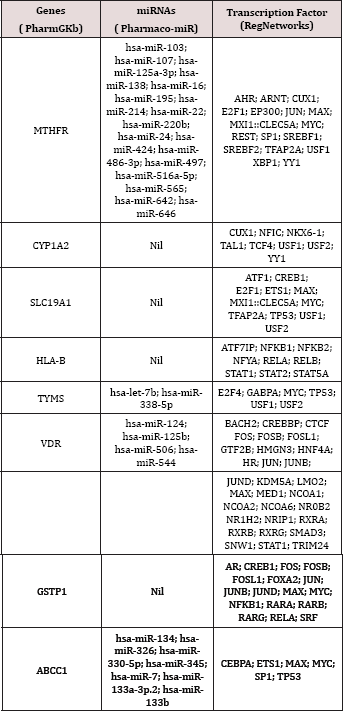
Further the genes, miRNAs and proteins in indirect approach were subjected to network analysis and the further details about the statistical methods were given below.
Network Construction & Analysis (Cytohubba)
Genes and their regulators were subjected to the analysis by various statistical methods (Degree, Edge Percolated Component, Maximum Neighborhood Component, Density of Maximum Neighborhood Component, and Maximal Clique Centrality with six centralities Bottleneck, EcCentricity, Closeness, Radiality, Betweenness and Stress) to identify their connectivity and the results are given in (Table 2 & Figure 1).
Figure 1: MCC Analysis of genes and regulators (Cytohubba).
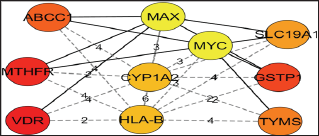
Table 2: Network Analysis of Regulators
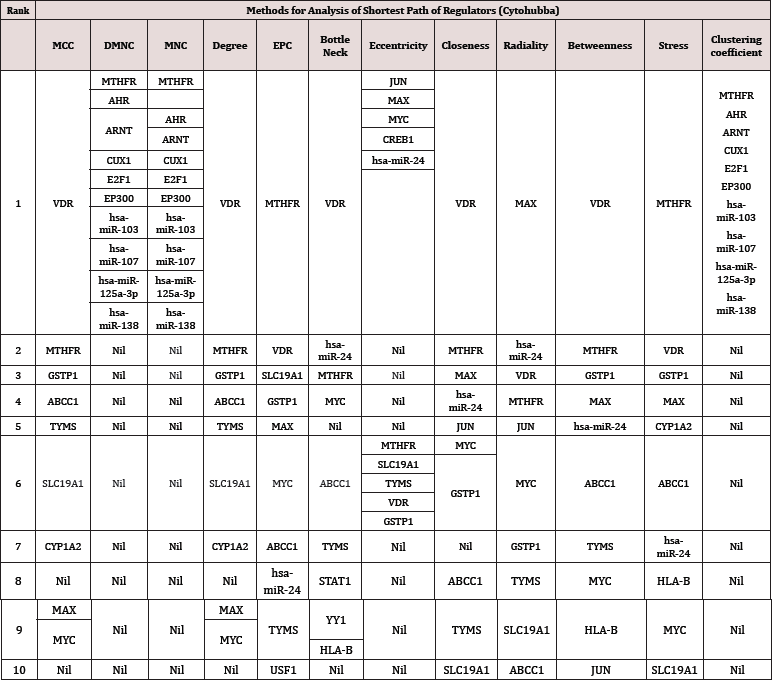
In case of MCC analysis in direct approach; VDR, MTHFR, GSTP1, ABCC1, TYMS and SLC19A1 were ranked from 1 to 6 respectively. Then; CYP1A2 and HLA-B were ranked 7.Finally; MAX and MYC were ranked 9.VDR polymorphism is associated with Psoriasis (Figure 2).
Figure 2: DMNC Analysis of genes and regulators (Cytohubba).
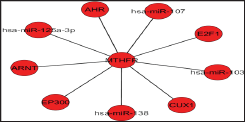
In case of DMNC analysis in direct approach; MTHFR, AHR, ARNT, CUX1, E2F1, EP300, hsa-miR-103, hsa-miR-107, hsa-miR- 125a-3p and hsa-miR-138 were ranked 1. MTHFR polymorphism is a possible factor for reducing the clinical severity of psoriasis (Figure 3).
Figure 3: MNC Analysis of genes and regulators (Cytohubba).

In case of MNC analysis in direct approach; MTHFR, AHR, ARNT, CUX1, E2F1, EP300, hsa-miR-103, hsa-miR-107, hsa-miR-125a- 3p and hsa-miR-138 were ranked 1. MTHFR polymorphism is a possible factor for reducing the clinical severity of psoriasis (Figure 4).
Figure 4: Degree Analysis of genes and regulators (Cytohubba).
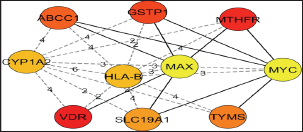
In case of degree analysis in direct approach; VDR, MTHFR, GSTP1, ABCC1, TYMS and SLC19A1 were ranked from 1 to 6 respectively. Then; CYP1A2 and HLA-B were ranked 7. Finally; MAX and MYC were ranked 9. VDR polymorphism is associated with Psoriasis (Figure 5).
Figure 5: EPC Analysis of genes and regulators (Cytohubba).
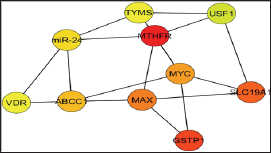
In case of EPC analysis in direct approach; MTHFR, VDR, SLC19A1, GSTP1, MAX, MYC, ABCC1, hsa-miR-24, TYMS and USF1 were ranked from 1 to 10 respectively. MTHFR polymorphism is a possible factor for reducing the clinical severity of psoriasis (Figure 6).
Figure 6: Bottleneck Analysis of genes and regulators (Cytohubba).

Figure 7: Eccentricity Analysis of genes and regulators (Cytohubba).

In case of Bottleneck Analysis in direct approach; VDR, hsa- miR-24 and MTHFR were ranked from 1 to 3.Then, MYC and GSTP1 were ranked 4. Further; ABCC1, TYMS and STAT1 were ranked from 6 to 8. Finally, YY1and HLA-B was ranked 9. VDR polymorphism is associated with Psoriasis (Figure 7).
In case of Eccentricity Analysis in direct approach; JUN, MAX, MYC, CREB1 and hsa-miR-24 were ranked as "First". Then; MTHFR, SLC19A1, TYMS, VDR and GSTP1 were ranked 6. JUN is associated with psoriasis because it's involved in the epidermal signaling (Figure 8).
Figure 8: Closeness Analysis of genes and regulators (Cytohubba).
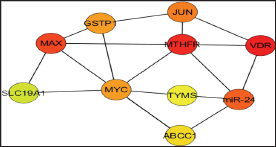
In case of Closeness Analysis in direct approach; VDR, MTHFR, MAX, hsa-miR-24 and JUN were ranked from 1 to 5 respectively. Then, MYC and GSTP1 were ranked 6.Further; ABCC1, TYMS and SLC19A1 were ranked from 8 to 10 respectively. VDR polymorphism is associated with Psoriasis (Figure 9).
Figure 9: Radiality Analysis of genes and regulators (Cytohubba).

In case of Radiality Analysis in direct approach; MAX, hsa- miR-24, VDR, MTHFR, JUN, MYC, GSTP1, TYMS, SLC19A1 and ABCC1 were ranked from 1 to 10 respectively (Figure 10).
Figure 10: Betweenness Analysis of genes and regulators (Cytohubba).
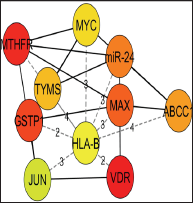
In case of between's Analysis in direct approach; VDR, MTHFR, GSTP1, MAX, hsa-miR-24, ABCC1, TYMS, MYC, HLA-B and JUN were ranked from 1 to 10 respectively (Figure 11).
Figure 11: Stress Analysis of genes and regulators (Cytohubba).
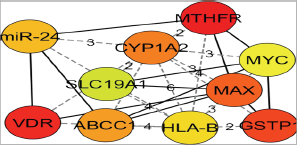
VDR polymorphism is associated with Psoriasis. In case of Stress Analysis in direct approach; MTHFR, VDR, GSTP1, MAX, CYP1A2, ABCC1, hsa-miR-24, HLA-B, MYC and SLC19A1 were ranked from 1 to 10. MTHFR polymorphism is a possible factor for reducing the clinical severity of psoriasis (Figure 12).
Figure 12: Clustering Coefficient Analysis of genes and regulators (Cytohubba).
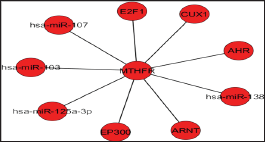
In case of clustering coefficient Analysis in direct approach; MTHFR, AHR, ARNT, CUX1, E2F1, EP300 hsa-miR-103, hsa- miR-107, hsa-miR-125a-3p and hsa-miR-138 were ranked from 1 to 10. MTHFR
Polymorphism is a possible factor for reducing the clinical severity of psoriasis. Compatibility of miRNA with respect to gene- miRNA interaction was analyzed by miRmap and the results are given in (Table 3).
Table 3: Compatibility Analysis of Micro RNAs.
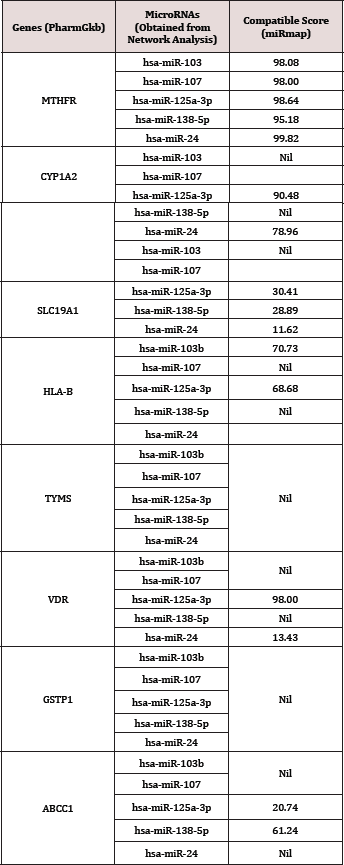
Conclusion
Overall network analysis of pharmacogenomic based regulatory network in psoriasis resulted in identifying 25 potential regulators of Psoriasis [20 Transcription Factors (VDR, MTHFR, GSTP1, ABCC1, TYMS, SLC19A1, CYP1A2, HLA-B, MAX, MYC, AHR, ARNT, CUX1, E2F1 and EP300) and 5 mi RNAs (hsa-miR-103, hsa-miR-107, hsa-miR-125a-3p, hsa-miR-138 and hsa-miR-24)]. Among those 5 potential mi RNAs, has-miR-125a-3p is highly compatible with most of genes involved in the pharmacogenomics of Psoriasis on the basis gene-mi RNA binding. In biological context, hsa-miR-125a-3p has a maximum probability to become a potential biomarker to diagnose and treat Psoriasis in future.
Read More About Lupine Publishers Journal of Biomedical Engineering and Biosciences Please Click on Below Link: https://biomedical-sciences-lupine-publishers.blogspot.com/

No comments:
Post a Comment
Note: only a member of this blog may post a comment.